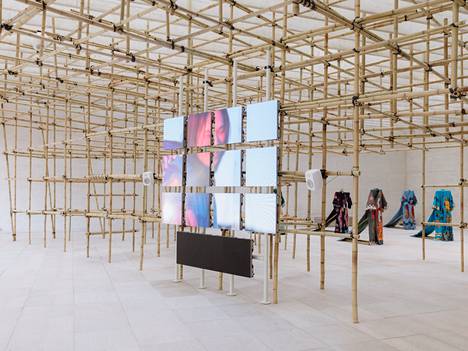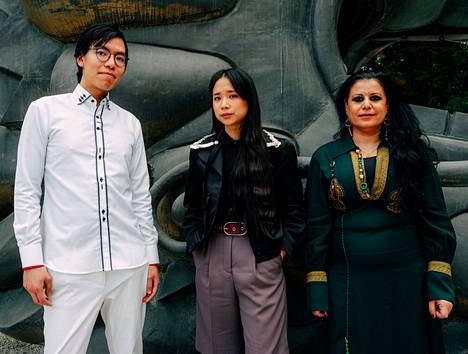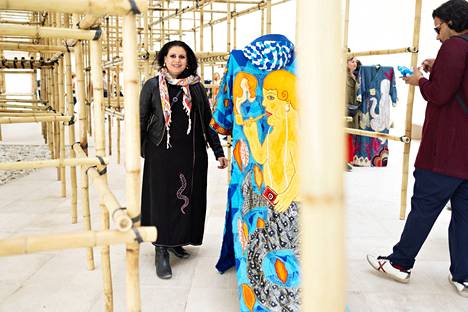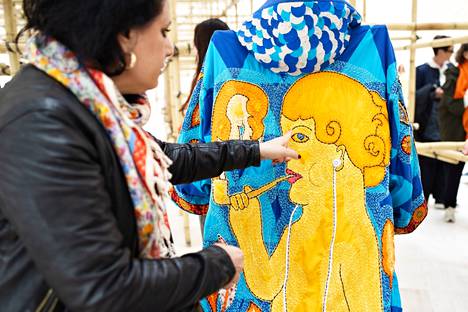Source: Helsingin Sanomat
4.5.2024
Aino Frilander
PRESS TEXT
In English (Translated)
Read the full article in Finnish here: https://www.hs.fi/kulttuuri/art-2000010368435.html
Kholod Hawash is rapidly making a name for herself in the Finnish art scene, and now her works are attracting attention worldwide.
Kholod Hawash, who moved from Iraq to Finland, is one of the three artists in the Nordic Pavilion. Her body of work, inspired by Cantonese opera, was one of the most anticipated exhibits at the Venice Biennale.

One artwork is particularly visible from afar at Venice’s Giardini: a five-meter-tall dragon head rising in front of the Nordic Pavilion’s minimalist and elegant facade.
Upon closer inspection, it becomes clear that the pavilion has transformed into a dragon ship this year: the dragon head serves as the figurehead, and a dragon tail swishes behind. The central bamboo structure mimics the streamlined belly of the ship.
These elements are part of Swedish artist Lap See Lam’s work titled “The Altersea Opera,” one of the most anticipated pieces at this year’s Biennale.
“The Altersea Opera” is an “opera” that anyone wandering into the dragon ship within the Giardini can experience. The 60-minute video and sound piece tells the story of Lo Ting, a fish-man from Cantonese mythology, who longs to return to his home, the “fragrant harbor,” which is the literal translation of Hong Kong.

The Altersea Opera is a sound and video piece. Unlike the hit of the 2019 Biennale, Lithuania’s pavilion with the Sun & Sea opera, it does not need to be experienced “live.” PHOTO: MATTEO DE MAYDA
In Helsinki, as part of the latest Ars Fennica -exhibition , Lam was responsible for the overall production and wrote the opera’s libretto. The Norwegian composer Tze Yeung Ho, who resides in Helsinki and shares Hong Kong roots with Lam, composed the opera’s music, which combines contemporary music, Karelian laments, and lullabies sung in Arabic.
However, it is Kholod Hawash, who officially represents Finland in the pavilion, having designed the costumes for the opera.
The Nordic Pavilion is a joint effort of Finland, Sweden, and Norway, with the countries taking turns to lead the project. This time, it was Sweden’s turn.
The bow and stern of the dragon ship originate from the Sea Palace restaurant ship built in Shanghai, which has appeared in previous works by Lap See Lam and has lived many lives. For years, it served as a floating restaurant in Sweden, and in its twilight years, it was a ghost ship at the Gröna Lund amusement park. Now, its hull lies abandoned at a shipyard in the Stockholm archipelago.
Curator Asrin Haidari tactfully refrains from divulging the details, but transporting the ship parts from Sweden to Venice was no easy task. However, it was undertaken because it was essential to Lap See Lam’s vision, Haidari explains. The idea was to incorporate different temporal layers into the work, with the fantastical dragon ship acquiring various meanings in different contexts – in Chinese waters, in the icy sea off Gothenburg, in an amusement park, and now finally in Venice, at the heart of the art world festivities.

Tze Yeung Ho, Lap-See Lam, and Kholod Hawash are the artists representing the Nordic Pavilion at this year’s Venice Biennale. PHOTO: JAN AHLSTEDT
Lap See Lam, who grew up in a Chinese restaurant run by her parents, is interested in migration and the layered identities of immigrants. What is it like to be neither here nor there, not entirely one thing nor another? When people and objects move from one culture to another, something is always lost. The dragon ship, too, is a kind of immigrant, no longer admired in Sweden as it was in its home port, despite the masterful craftsmanship.
“I had to have that exact head and tail,” Lap See Lam says. “I couldn’t compromise on that. I wanted to bring the dragon symbol to life and make it something new.”
Kholod Hawash joined the project after Lap See Lam and Asrin Haidari saw her works in the Kiasma Ars exhibition.
Hawash, who came to Finland from Iraq in 2019 through the Artists at Risk program , worked as a children’s book illustrator in Iraq. In Finland, she has risen to the forefront of visual art with her textile works, which she creates using recycled materials and traditional patchwork techniques, stitch by stitch. Often, the themes of her pieces draw not only from Iraqi folklore but also from women’s experiences and the longing for independence.

Kholod Hawash has created the costumes for The Altersea Opera. PHOTO: OUTI PYHÄRANTA / HS

Kholod Hawash showcases the traditional jodaleia patchwork technique, which she learned from her mother. All the costumes are handmade. PHOTO: OUTI PYHÄRANTA / HS